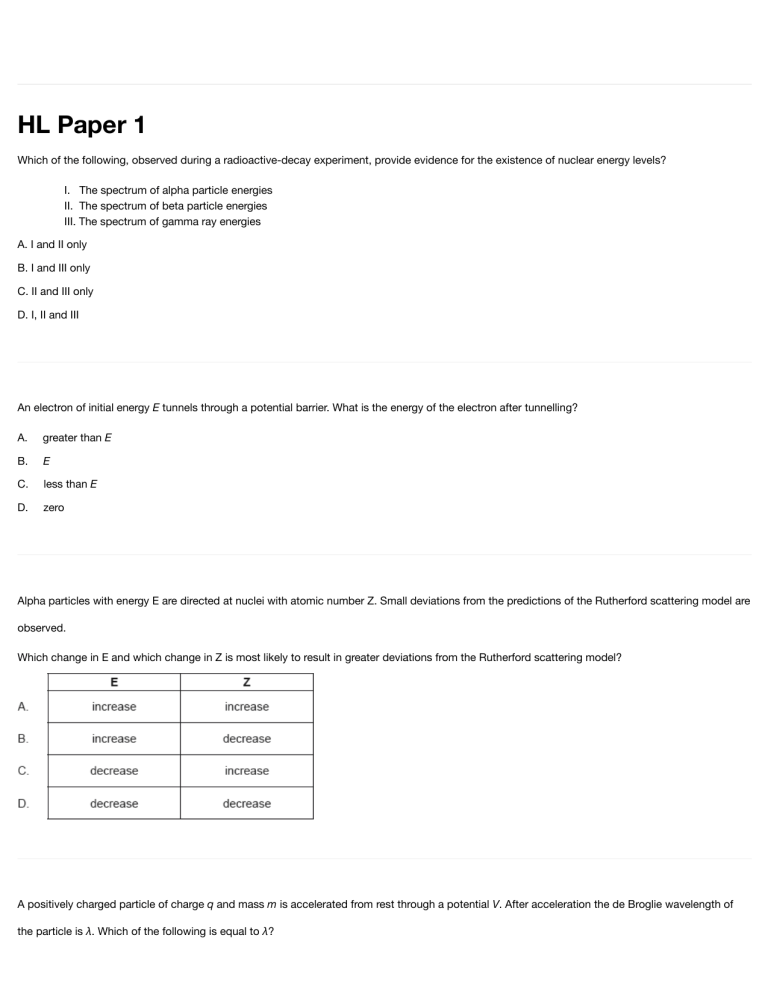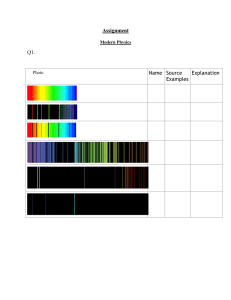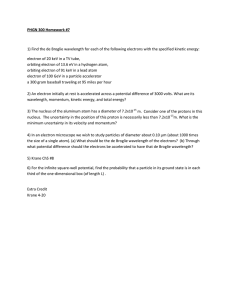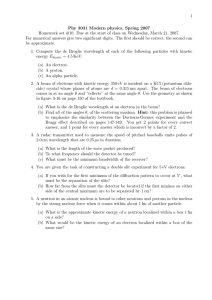
HL Paper 1 Which of the following, observed during a radioactive-decay experiment, provide evidence for the existence of nuclear energy levels? I. The spectrum of alpha particle energies II. The spectrum of beta particle energies III. The spectrum of gamma ray energies A. I and II only B. I and III only C. II and III only D. I, II and III An electron of initial energy E tunnels through a potential barrier. What is the energy of the electron after tunnelling? A. greater than E B. E C. less than E D. zero Alpha particles with energy E are directed at nuclei with atomic number Z. Small deviations from the predictions of the Rutherford scattering model are observed. Which change in E and which change in Z is most likely to result in greater deviations from the Rutherford scattering model? A positively charged particle of charge q and mass m is accelerated from rest through a potential V. After acceleration the de Broglie wavelength of the particle is λ. Which of the following is equal to λ? A. B. C. D. A proton and an alpha particle have the same de Broglie wavelength. Which of the following is approximately the ratio ? A. B. C. 2 D. 4 A particle has a de Broglie wavelength and kinetic energy . What is the relationship between and ? A. B. C. D. A particle is accelerated from rest through a potential difference associated with the particle varies with ? . Which of the following graphs best shows how the de Broglie wavelength Two radioactive nuclides, X and Y, have half-lives of 50 s and 100 s respectively. At time t = 0 samples of X and Y contain the same number of nuclei. What is A. 4 B. 2 when t = 200 s? C. D. A photoelectric cell is connected in series with a battery of emf 2 V. Photons of energy 6 eV are incident on the cathode of the photoelectric cell. The work function of the surface of the cathode is 3 eV. What is the maximum kinetic energy of the photoelectrons that reach the anode? A. 1 eV B. 3 eV C. 5 eV D. 8 eV Monochromatic electromagnetic radiation is incident on a metal surface. The kinetic energy of the electrons released from the metal A. is constant because the photons have a constant energy. B. is constant because the metal has a constant work function. C. varies because the electrons are not equally bound to the metal lattice. D. varies because the work function of the metal is different for different electrons. Which of the following is evidence for the wave nature of the electron? A. Continuous energy spectrum in β– decay B. Electron diffraction from crystals C. Existence of atomic energy levels D. Existence of nuclear energy levels A beam of electrons is accelerated from rest through a potential difference accelerated through a potential difference of . The de Broglie wavelength of the electrons is . For electrons the de Broglie wavelength is A. B. C. D. The following observations are made during nuclear decays. I. Discrete energy of alpha particles II. Continuous energy of beta particles III. Discrete energy of gamma rays Which of the observations provide evidence of the existence of nuclear energy levels? A. I only B. II only C. I and III only D. I, II and III A particle of fixed energy is close to a potential barrier. Which changes to the width of the barrier and to the height of the barrier will always make the tunnelling probability greater? What can be used to calculate the probability of finding an electron in a particular region of space? A. B. C. The magnitude of the wave function D. The magnitude of the (wave function)2 The half-life of a radioactive isotope is 10 days. What is the percentage of the sample remaining after 25 days? A. 0 % B. 18 % C. 25 % D. 40 % Evidence for nuclear energy levels comes from discrete energies of I. alpha particles II. beta particles III. gamma ray photons. Which of the above statements is/are true? A. I and II only B. I and III only C. II only D. III only A neutron of mass m is confined within a nucleus of diameter d. Ignoring numerical constants, what is an approximate expression for the kinetic energy of the neutron? A. B. C. D. Which of the following experiments provides evidence for the existence of matter waves? A. Scattering of alpha particles B. Electron diffraction C. Gamma decay D. Photoelectric effect Ultra-violet light is shone on a zinc surface and photoelectrons are emitted. The sketch graph shows how the stopping potential frequency . Planck’s constant may be determined from the charge of an electron A. the -intercept. B. the -intercept. C. the gradient. D. the area under the graph. multiplied by According to the Heisenberg uncertainty principle the quantity paired with momentum is varies with A. time. B. energy. C. position. D. mass. Two samples X and Y of different radioactive isotopes have the same initial activity. Sample X has twice the number of atoms as sample Y. The half-life of X is T. What is the half-life of Y? A. 2T B. T C. D. A photon interacts with a nearby nucleus to produce an electron. What is the name of this process? A. Pair annihilation B. Pair production C. Electron diffraction D. Quantum tunnelling In the Schrödinger model of the hydrogen atom, the probability of finding an electron in a small region of space is calculated from the A. de Broglie hypothesis. B. Heisenberg uncertainty principle. C. (amplitude of the wavefunction)2. D. rms value of the wavefunction. Deviations from Rutherford scattering are detected in experiments carried out at high energies. What can be deduced from these deviations? A. The impact parameter of the collision B. The existence of a force different from electrostatic repulsion C. The size of alpha particles D. The electric field inside the nucleus An electron is accelerated from rest through a potential difference . Which of the following is the de Broglie wavelength of the electron after acceleration? A. B. C. D. According to the Bohr model for hydrogen, visible light is emitted when electrons make transitions from excited states down to the state with n = 2. The dotted line in the following diagram represents the transition from n = 3 to n = 2 in the spectrum of hydrogen. Which of the following diagrams could represent the visible light emission spectrum of hydrogen? Nuclear density A. is constant because the volume of a nucleus is proportional to its nucleon number. B. is constant because the volume of a nucleus is proportional to its proton number. C. depends on the nucleon number of the nucleus. D. depends on the proton number of the nucleus. A radioactive element has decay constant nuclei that will have decayed after 1 s? A. B. C. D. (expressed in s–1). The number of nuclei of this element at t = 0 is N. What is the expected number of The radii of nuclei may be determined by A. scattering charged particles off the nuclei. B. injecting the nuclei in a mass spectrometer. C. measuring the de Broglie wavelength of the nuclei. D. observing the spectrum of the nuclei. An electron of mass m has an uncertainty in its position r. What is the uncertainty in the speed of this electron? A. B. C. D. Which of the following is an assumption of the Schrödinger model of the hydrogen atom? A. The orbital path of the electron fits a standing wave. B. The position of the electron is undefined but its momentum is well defined. C. The momentum of the electron is undefined but its position is well defined. D. The electron is described by wavefunctions. Photoelectrons are emitted at a certain rate when monochromatic light is incident on a metal surface. Light of the same intensity but of higher frequency is now used. After this change, the rate of emission of electrons from the surface is A. zero. B. lower. C. the same. D. higher. When the cathode of a photoelectric cell is illuminated with red light, a photoelectric current is produced in the cell. The illumination is changed to blue light but the rate at which photons arrive at the cathode remains the same. Which of the following statements is/are correct under these conditions? I. The number of electrons released is unchanged II. The current falls to zero III. The kinetic energy of the electron increases A. I only B. III only C. I and II only D. I and III only In the photoelectric effect, the following observations may be made. I. The kinetic energy of the emitted electrons increases with increasing light frequency. II. The electrons are emitted without time delay. Which of these observations, if any, can be explained in terms of the wave theory of light? A. Neither I nor II B. I and II C. I only D. II only Light that is shone onto a metal surface may result in the emission of electrons from the surface. Three statements regarding the emission of the electrons are the I. number of electrons emitted per unit time depends on the intensity of the incident light II. energy of the electrons depends on the frequency of the incident light III. emission of the electrons takes place instantaneously. Which of the above statements can only be explained by assuming light consists of photons? A. II only B. III only C. II and III only D. I, II and III When monochromatic light is incident on a metallic surface, electrons are emitted from the surface. The following changes are considered. I. Increase the intensity of the incident light II. Increase the frequency of light III. Decrease the work function of the surface Which changes will result in electrons of greater energy being emitted from the surface? A. I and II only B. I and III only C. II and III only D. I, II and III The diameter of a silver-108 ( ) nucleus is approximately three times that of the diameter of a nucleus of A. B. C. D. The square of the amplitude of the electron wave function in an hydrogen atom is a measure of the A. uncertainty in position of the electron. B. momentum of the electron. C. probability of finding an electron at a particular point. D. uncertainty in the velocity. An electron accelerated from rest through a potential difference V has de Broglie wavelength λ. What is the wavelength of an electron accelerated from rest through a potential difference of 2V? A. 2λ B. C. D. In the “electron in a box” model, an electron is confined to move along a line of length L. What is the smallest possible value of the momentum of the electron? A. 0 B. C. D. If there is no uncertainty in the value of the de Broglie wavelength of a particle then this means that A. both the momentum and position of the particle are known precisely. B. the position of the particle is known precisely but all knowledge of its momentum is lost. C. both the energy and the position of the particle are known precisely. D. only the momentum of the particle is known precisely but all knowledge of its position is lost. When electromagnetic radiation falls on a photocell, electrons of mass is the maximum speed of the electron when radiation of frequency are emitted, provided the frequency of the radiation is greater than falls on the photocell? A. B. C. D. Three phenomena associated with nuclear and quantum physics are I. Einstein photoelectric effect II. de Broglie hypothesis III. Rutherford alpha particle scattering. Which of the phenomena can be verified by firing electrons at a metal surface? A. I only B. II only C. I and III only D. II and III only Which of the following is a correct statement associated with the photoelectric effect? A. Electron emission is instantaneous. B. Electrons are only emitted if the incident light is above a certain minimum wavelength. C. The energy of the emitted electrons depends on the light intensity. D. The energy of the emitted electrons does not depend on the frequency of the incident light. The radii of nuclei can be estimated from experiments involving A. the scattering of charged particles. . What B. the Bainbridge mass spectrometer. C. emission spectra. D. beta particle spectra. In the Bohr model for hydrogen an electron in the ground state has orbit radius r and speed v. In the first excited state the electron has orbit radius 4r. What is the speed of the electron in the first excited state? A. B. C. D. Photons are incident on a metal surface. Electrons are emitted from the surface. What single change may result in no electrons being emitted from the surface? A. Doubling the wavelength of the photons B. Halving the wavelength of the photons C. Doubling the number of photons incident on the surface per second D. Halving the number of photons incident on the surface per second The magnitude of the uncertainty in the position of a particle is equal to the de Broglie wavelength of the particle. Which of the following is the minimum uncertainty in the momentum p of the particle? A. B. C. D. An electron X is accelerated from rest through a potential difference V. Another electron Y is accelerated from rest through a potential difference 2V. After acceleration, the de Broglie wavelength of X is λX and that of Y is λY. The speeds reached by the electrons are well below that of the speed of light. What is the ratio A. 2 ? B. C. D. In the Heisenberg uncertainty principle, conjugate quantities are pairs of quantities that cannot both be known precisely at the same instant. What unit is used for the product of the conjugate quantities? A. kg m2s-3 B. kg m2s-2 C. kg m2s-1 D. kg m2s Light of a particular wavelength and intensity does not cause photoelectric emission from a clean metal surface in a vacuum. Which of the following changes to the light might cause photoelectric emission? A. Increase the intensity B. Decrease the intensity C. Increase the wavelength D. Decrease the wavelength The decay constant of a radioactive isotope is 10–3s–1. Which of the following is the probability that a nucleus of the isotope will decay in the next second? A. B. 1000 C. 1000 ln2 D. Different metal surfaces are investigated in an experiment on the photoelectric effect. A graph of the variation of the maximum kinetic energy of photoelectrons with the frequency of the incident light is drawn for each metal. Which statement is correct? A. All graphs have the same intercept on the frequency axis. B. The work function is the same for all surfaces. C. All graphs have the same slope. D. The threshold frequency is the same for all surfaces. Which particles are emitted in β+ decay? A. Positron and neutrino B. Positron and antineutrino C. Electron and neutrino D. Electron and antineutrino The probability of finding an electron at a particular position in a hydrogen atom is proportional to the A. wavefunction. B. square of the wavefunction. C. amplitude of the wavefunction. D. square of the amplitude of the wavefunction. An electron of mass me and a proton of mass mp are moving with the same kinetic energy at non-relativistic speeds. The de Broglie wavelengths associated with the electron and the proton are λe and λp respectively. Which of the following correctly gives the ratio ? A. B. C. D. A proton is confined within a nucleus. What is the order of magnitude of the uncertainty in its momentum? A. 10–30 Ns B. 10–20 Ns C. 10–10 Ns D. 1 Ns The decay constant of a radioactive isotope with half-life T is defined as A. . B. the rate of decay of one nucleus of the isotope per second. C. Tln2. D. the probability of decay of one nucleus of the isotope per unit of time. Three types of radiation emitted from radioactive materials are given below. I. Alpha II. Beta III. Gamma Which type(s) of radiation has/have a discrete energy when emitted from radioactive materials? A. I only B. I and III only C. I and II only D. I, II and III Which of the following is correct for the de Broglie wavelength λ of a particle when the kinetic energy of the particle is EK? A. B. C. D. According to the Heisenberg uncertainty principle, conjugate quantities are pairs of quantities that cannot be known precisely for the same object at the same time. What is the unit when two conjugate quantities are multiplied together? A. kg m2s–1 B. kg2m s–1 C. kg m2s D. kg m2s–2 Electrons are accelerated from rest through a potential difference V. Their de Broglie wavelength is λ. The accelerating potential difference is increased to 2V. Which of the following gives the new de Broglie wavelength? A. 2λ B. C. D. A radioactive substance S has a decay constant λS, substance T has a decay constant λT. Initially a sample of S contains NS nuclei and a sample of T contains NT nuclei. The initial activity of both samples is the same. The ratio is A. 1 B. C. D. λSλT A radioactive nuclide decays to a stable daughter nuclide. Initially the sample consists entirely of atoms of the radioactive nuclide. What fraction of the sample consists of the daughter nuclide after four half-lives? A. B. C. D. Which phenomenon provides evidence for the wave nature of an electron? A. Line spectra of atoms B. Photoelectric effect C. Beta decay of nuclei D. Scattering of electrons by a crystal Which of the following provides evidence for the quantization of nuclear energy levels? I. Alpha particles have discrete values of kinetic energies II. Gamma-ray photons have discrete energies III. Atomic line emission spectra A. I only B. II only C. I and II only D. I, II and III A radioactive sample of initial activity 12.0Bq has a half-life of 3.0 days. Which of the following is the activity after 4.0 days? A. 3.0 Bq B. 3.8 Bq C. 4.0 Bq D. 4.8 Bq The decay constant is the probability of the A. number of radioactive decays per unit time. B. decay of a nucleus per unit time. C. decay of a nucleus. D. number of nuclei decaying in any given time. Light of frequency is incident on a metal surface. The work function of the metal is . Which of the following is the maximum kinetic energy of the electrons emitted from the surface? A. B. C. D. Different nuclides spontaneously undergo radioactive decay, emitting either α, β or γ radiation. Which of the following correctly identifies all the emissions that do not have discrete energies? A. α B. β C. γ D. α and γ Alpha particles of charge +2e and mass m are accelerated from rest through a potential difference V. Planck’s constant is h. Which of the following gives the de Broglie wavelength of the alpha particles as a result of the acceleration? A. B. C. D. hmV A photon of energy E and wavelength λ is scattered from an electron initially at rest. What is the energy of the photon and the wavelength of the photon when the electron moves away? Samples of different radioactive nuclides have equal numbers of nuclei. Which graph shows the relationship between the half-life for the samples? and the activity A Pair production by a photon occurs in the presence of a nucleus. For this process, which of momentum and energy are conserved? Electron capture can be represented by the equation p + e– → X + Y. What are X and Y? The diagram below shows a circuit involving a photoelectric cell. When UV light is shone onto the metal cathode, electrons are emitted establishing a photocurrent. Which of the following changes could cause the photocurrent to stop A. Increasing the potential difference of the power supply. B. Increasing the frequency of the UV light. C. Increasing the intensity of the UV light. D. Changing the metal surface to one with a smaller work function. A pure sample of mass m of a radioactive substance with half-life has an initial activity A0. What are the half-life and the initial activity of a pure sample of mass 2m of the same radioactive substance? Light is shone onto the surface of a metal and photoelectrons are emitted. Which of the following changes of wavelength and intensity of the light will increase the maximum kinetic energy of the photoelectrons? A particular radioactive substance decays and emits both β particles and neutrinos. Which describes the nature of the energy spectrum of the β particles and the nature of the energy spectrum of the neutrinos? Photoelectrons are emitted from the surface of a metal when light of frequency ƒ is incident on it. Which of the following shows the variation with ƒ of the maximum kinetic energy Ek of the photoelectrons? The graphs show the variation with distance x of the square of the amplitude Ψ2 of the wave function of a particle. Which graph corresponds to a particle with the largest uncertainty in momentum? Red light incident on a metal surface produces photoelectrons. The potential V of the supply is varied and the current is measured. The results are shown on the graph. The light source is changed to blue. This blue source emits the same number of photons per second as the red source. Which graph shows the variation with potential of current for blue light? The results for the red light are shown as a dashed line. Monochromatic light is incident on a metal surface and electrons are released. The intensity of the incident light is increased. What changes, if any, occur in the rate of emission of electrons and the kinetic energy of the emitted electrons?




